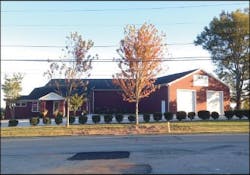Apple Collision Centers/Pritz Auto Body Inc.
Location: Seven locations surrounding York, PA.
Staff: 90
Average Monthly Car Count: 865
Annual Revenue: $24 million
You’ve seen vending machines filled with chips, soda, water, candy bars. But you’ve probably never seen one filled with seam sealer, sandpaper, clips, bulbs, undercoating.
Chris Sechrist hadn’t seen one either—that’s why he gave the idea life.
“One of the things we struggle with in this industry is inventorying paint and materials and getting reimbursed for them,” he says. “So I designed a system called CollisionVend, which enables us to stock a select amount of items in a vending machine that controls that inventory.”
But more on CollisionVend later. For now, let’s focus on the philosophy behind that quote.
With seven years as the owner of Apple Collision Centers (four locations) and Pritz Auto Body Inc. (three locations) under his belt and 20 years of experience in the industry overall, Sechrist has encountered common problems all shop owners experience: low paint and materials profits, battling for reimbursement from insurance companies, high cycle times, supplement delays.
“Some people don’t want to invest the time to manage their business,” he says. “The people really involved in their business who really care about the customers and the bottom line and the health of the store? They embrace change.”
Since the first Apple Collision location—a 30,000-square-foot facility—opened in 2009, Sechrist’s network has flourished to seven shops in the York, Penn., area that combine for $24 million in sales. He says the company’s rapid growth has been fueled by management’s ability to assess problems and then work with employees to implement tangible methods of improving processes across all seven facilities—resulting in game-changing innovations like CollisionVend.
Growing the Right Team
—
“Measure everything, manage anything,” he says.
As director of operations for all seven collision centers, Kriser embodies Sechrist’s focus on constant improvement: He is always evaluating the repair process, tinkering with procedures, and inspiring change among staff members.
With 90 employees across seven locations, Sechrist admits change isn’t always easy. But when you’ve formed a management team that buys into that change? It becomes easier to do on a broader scale.
Sechrist says most of his managers started at the front counter and worked their way through the ranks. And once in that upper management position, each manager’s main focus is grooming new management candidates to aid with the shop’s goal to open two new facilities every year.
This attention to ongoing training and development of his employees has led to very low turnover rates, which Sechrist says signals that his staff has bought into his philosophies.
“We simply take care of our people,” he says. “We do what we say we will do and provide them with all the tools necessary to succeed in their career.”
Assessing Processes
—
For Sechrist and his management staff, creating company-wide change starts with its monthly internal 20 Groups meetings, where managers discuss data culled from every store to find weak spots.
“We discuss and review financials for each particular store,” Sechrist says. “We compare each location to one another based on set KPIs, comparing gross profits, cycle times, expenses. We also compare our performance with other non-competitive stores of our same size and revenue throughout the USA based upon information from various composite reports.”
These meetings include process managers situated at each location, constantly evaluating movement between the estimating, body, paint and parts departments, and noting potential repair process tweaks. On a per-car basis, they record any disturbances on flow interruption sheets. Their findings are compiled by Kriser into spreadsheets for 20 Group meetings, where they record disciplined processes for all shops to follow.
“Each one of our stores mirrors the process,” Sechrist says. “You can walk into any one of our stores and they all operate the same.”
GROOMING MANAGEMENT
SEGMENTING ESTIMATORS
HOW COLLISIONVEND WORKS
Finding Viable Solutions
—
What’s resulted from Apple/Pritz’s attentive management team is a number of changes that have improved cycle times and sales across the board. In particular, two of these changes have resulted in major returns:
PLACING ESTIMATORS IN THE BACK
The Problem: Kriser says management was reporting cycle time delays due to technicians waiting on supplements. While estimators were speaking with customers, taking photos of vehicles and addressing damages with insurance, supplement paperwork would sit idle, resulting in cycle times around 6.5 days.
The Solution: To help technicians remain productive, Kriser says management moved some estimators from the front counter to a permanent spot in the back, where their only jobs are attending to the body, paint and parts departments. The front-end and back-end estimators communicate with each other via radio and the shop’s management system.
“Those guys are out in the facility, all day every day, taking care of everything that has to happen with supplements so we can be continually touching cars and not just sitting around,” he says. “It eliminates all parts issues and questions on the backside, and then the estimators in the front have that much more time to spend with customers.”
The Results: Not only has the new system virtually eliminated all parts issues and questions on the backside, Sechrist says, but it has also helped to lower cycle times across all seven shops to 5.3 days.
STREAMLINING MATERIALS INVENTORY
The Problem: The biggest problem plaguing Apple/Pritz for a long time, Sechrist says, was low profits on paint and materials, stemming from an influx of materials, theft from employees, and difficulties in getting reimbursed from insurance companies.
The Solution: Working with ComCept Solutions—a software company that partners with paint jobbers across the country—Sechrist developed CollisionVend, which tracks material use and streamlines the inventory process.
“Each store had technicians who all wanted their preferred body filler or seam sealer,” Sechrist says. “Management came together, decided on one product from every category, and required that every shop use those products.”
The Results: The system not only reduced how many materials were purchased, but thanks to a card-swiping system that records who is using the vending machine, it eliminated all theft issues.
Sechrist has even been able to hook CollisionVend up to his management system, which has improved his communication with both his insurance companies and distributors.
“It vends automatically, bills it directly to the repair order and attaches it to the estimate, automatically creating an invoice for the insurance company,” he says. “It records any product we use on a particular vehicle so there’s no guesswork for what was used on a repair. An insurance company can’t say that, ‘Hey, you inflated this or made up an invoice.’
“The system also directly links to distributors for the products. It tells the distributor the usage, and then it automatically gets refilled based on inventory amounts.”
By consolidating part numbers and condensing products in multiple machines, CollisionVend has decreased overall costs on materials by 2.5 percent. And by generating an automatic invoice from the vendor for the repair order, the system has also increased materials recovery from insurance by 3 percent.
“And when you’re talking about $24 million in sales, a few percentage points is a lot of money,” Sechrist says.
Creating Consistent Change
—
“Being able to sit down and talk to guys on the floor and have them understand what gets in our way and why we need these changes—that makes a difference,” he says. “Once they start to really think about it, it just becomes a journey, and guys are always thinking there is room for improvement.” That across-the-board commitment to constant improvement, Sechrist says, is what will allow his collision centers to thrive and expand for years to come.
“There are a lot of shops across the country that just do not welcome change,” he says. “They complain that profits are down, that they don’t get paid for this and that. But if you’re not willing to adjust and make changes, all you’ll ever do is complain and you’ll never improve. That’s the bottom line.”

